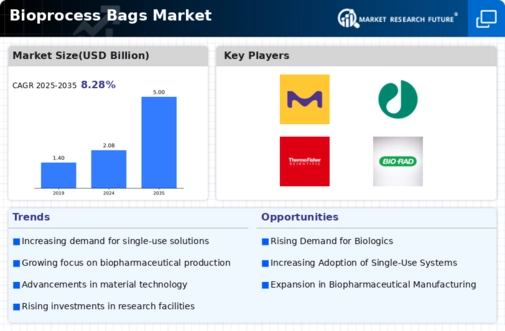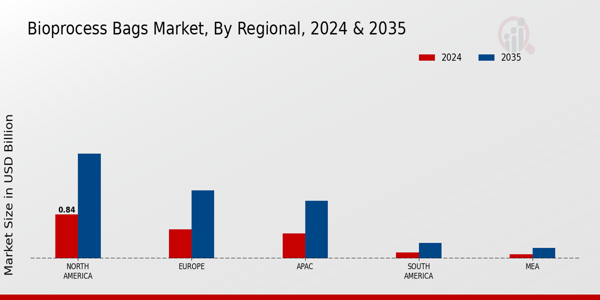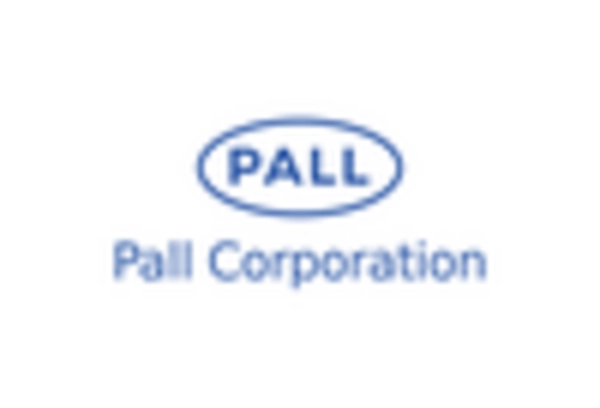Growing Focus on Regulatory Compliance
The increasing emphasis on regulatory compliance within the biopharmaceutical sector is driving the Bioprocess Bags Market. Regulatory bodies are imposing stringent guidelines to ensure the safety and efficacy of biopharmaceutical products. As a result, manufacturers are compelled to utilize high-quality bioprocess bags that meet these regulatory standards. The market for bioprocess bags is projected to grow at a compound annual growth rate of around 10% over the next few years, reflecting the rising need for compliant solutions. This trend indicates that companies are prioritizing the use of bioprocess bags that not only meet regulatory requirements but also enhance the overall quality of their products, thereby fostering growth in the Bioprocess Bags Market.
Increase in Biopharmaceutical Production
The biopharmaceutical sector is experiencing a notable increase in production capacity, which is likely to drive the Bioprocess Bags Market. As biopharmaceutical companies expand their manufacturing capabilities, the demand for bioprocess bags, which are essential for the storage and transport of biological materials, is expected to rise. In 2025, the biopharmaceutical market is projected to reach a valuation of approximately 500 billion USD, indicating a robust growth trajectory. This growth is attributed to the increasing prevalence of chronic diseases and the need for innovative therapies. Consequently, the Bioprocess Bags Market is poised to benefit from this expansion, as these bags are integral to maintaining the integrity of biopharmaceutical products during production and distribution.
Rising Demand for Cell and Gene Therapies
The surge in demand for cell and gene therapies is significantly impacting the Bioprocess Bags Market. As these therapies gain traction, the need for specialized bioprocessing solutions, including bioprocess bags, is becoming increasingly apparent. The market for cell and gene therapies is expected to reach approximately 100 billion USD by 2026, driven by advancements in genetic engineering and personalized medicine. This growth is likely to create a substantial demand for bioprocess bags that can accommodate the unique requirements of these therapies, such as maintaining sterility and preventing contamination. Consequently, the Bioprocess Bags Market is well-positioned to capitalize on this trend, as manufacturers seek reliable solutions to support the production of innovative therapies.
Technological Advancements in Bioprocessing
Technological advancements in bioprocessing are significantly influencing the Bioprocess Bags Market. Innovations such as improved materials and manufacturing techniques enhance the performance and reliability of bioprocess bags. For instance, the introduction of advanced polymer materials has led to bags that offer better barrier properties and reduced leachables, which are critical for maintaining product quality. Furthermore, automation in bioprocessing is streamlining operations, thereby increasing the efficiency of production processes. As these technologies continue to evolve, they are likely to create new opportunities within the Bioprocess Bags Market, potentially leading to increased adoption rates among manufacturers seeking to optimize their production workflows.
Expansion of Contract Manufacturing Organizations (CMOs)
The expansion of Contract Manufacturing Organizations (CMOs) is playing a pivotal role in shaping the Bioprocess Bags Market. As pharmaceutical companies increasingly outsource their manufacturing processes to CMOs, the demand for bioprocess bags is expected to rise correspondingly. CMOs are often required to adhere to strict quality standards, necessitating the use of high-quality bioprocess bags for their operations. The CMO market is projected to grow at a compound annual growth rate of around 8% in the coming years, reflecting the increasing reliance on outsourced manufacturing. This trend suggests that the Bioprocess Bags Market will likely experience growth as CMOs seek to enhance their operational efficiency and product quality through the use of advanced bioprocessing solutions.


















Leave a Comment